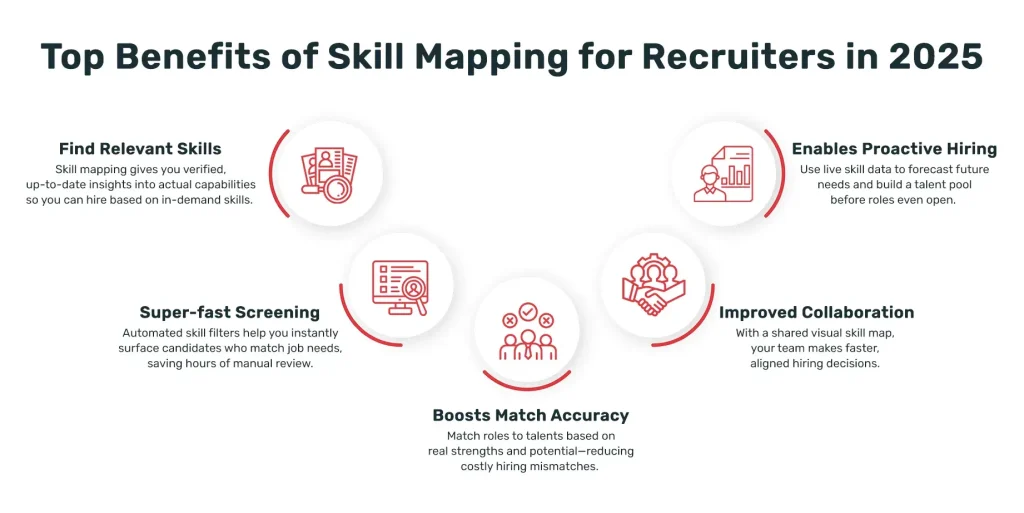To find hidden riches, a good map is your best friend. Also, to optimize your talent management operations, you’ll need a map, though a fascinating one.
For any organization to succeed today, you need a team with the right skills, but there is one problem: those right skills change so rapidly that it is difficult to keep up with the most demanding ones for the future workplace.
The solution is simple: skill mapping.
Skill mapping is critical for any organization looking to remain competitive in 2025 and beyond; it is the foundation of modern workforce development.
Think of it as creating a detailed snapshot of your organization’s capabilities. It reveals exactly what skills your people have, what level they’re at, and, most importantly, where the gaps might exist. This strategic approach strengthens talent retention, boosts employee productivity, and refines workforce planning.
As per Gallup, only 25.9% of the US employees strongly feel that their employers motivate and support learning new skills. This is compared to 42.9%, showing disproportionate access to skills development. Less than half of employees believe they lack the necessary abilities for excellent performance.
Here, we’ll discuss the importance of skill mapping and why it is a game-changer in today’s recruitment landscape.
Table of Contents
ToggleWhat Is Skill Mapping and Why It Matters in 2025?
Effective skill mapping ensures businesses have the right people in the right roles. By identifying key skills and comparing them with current capabilities, companies can fine-tune their recruitment efforts and build stronger teams.
Additionally, it has benefits beyond talent assessment. Here’s why businesses should take this method to enhance growth:
1. To bridge skill gaps
Businesses that understand their personnel well, including skills, competencies, weaknesses, and others, can address areas for growth and provide personalized training. This also creates an opportunity to reward strengths, which can encourage other employees to grow and learn.
2. To boost workforce planning
Employee allocation is the key to improving performance. While many people are eager to gain new skills, it is important to consider how they will impact specific sectors of the organization. Knowing everyone’s strengths allows your firm to strategically place certain people in critical jobs where they can contribute the most.
3. To offer career growth
When employees are offered clear career development opportunities, they become more engaged and devoted to their jobs. Implementing this approach can lower attrition rates while fostering greater employee engagement and satisfaction. Furthermore, it contributes to a culture of ongoing growth and development, inspiring others to invest in their own professional development.
4. To make informed decisions
By leveraging skill mapping, your HR team gains valuable insights that enhance recruitment strategies and optimize hiring decisions. Instead of searching through a large number of applicants, you already know who you need to fill a position or what abilities will benefit your team.
How Recruiters Win Big with Skill Mapping in 2025?
Today, recruiting is a whole different game. Job titles are blurry, resumes are unstructured, and the pressure to hire the right talent fast is higher than ever. Skill mapping is like a recruiter’s secret weapon.
The benefits include:
1. Finding the relevant skills
Traditional resumes are mostly keyword bingo. Skill mapping helps recruiters go beyond titles and years of experience. Instead of asking, “Did they work at a top company?” you’re asking, “Can they actually do what this role demands?” It’s all about verified, visible, and relevant skills.
2. Super-fast screening
Whether you’re recruiting for five roles or fifty, skill mapping helps recruiters quickly identify talent whose skills align with the job requirements.
3. Boosts match accuracy
You’re matching people to roles based on real skills, strengths, and potential. This means fewer mismatches and better outcomes for recruiting managers and candidates alike.
4. Improved collaboration within the recruiting team
When you’ve got a visual map of what skills a talent brings to the table and how they stack up against what the role needs, your conversations with the team become way more productive.
5. Enables proactive hiring
Recruiters can use skill maps to build talent pipelines—not just for today, but for roles that might open six months from now. With a living database of in-demand skills, you’re always one step ahead.
Thus, recruiters who use this strategy aren’t just filling roles. They’re curating talent, elevating hiring quality, and building smarter, more resilient teams.

The Rise of Talent Intelligence Platforms
Talent intelligence has fast become one of the most revolutionary aspects of HR technology. With constant industry changes, businesses are under immense pressure to pivot quickly and stay ahead of the curve. As per research, about 61.9% of organizations have already eliminated or plan to cut roles in the coming year. Furthermore, around 64.9% have discovered substantial talent gaps, and 89.9% have introduced new roles to address changing business demands.
These trends highlight the increasing necessity of a skills-based approach to talent management. As organizations are highly reliant on the right skills to navigate disruption, the HR department is turning to talent intelligence to measure and assess talent demands efficiently. Organizations can use this information to refine their talent strategies, ensuring alignment with current priorities while proactively preparing for future business needs.
By leveraging talent intelligence, businesses gain the visibility required to refine hiring decisions, strengthen employee development, and drive organizational success. As disruption continues to transform industries, exploiting these insights has become critical to sustaining a competitive advantage.
How Skill Mapping Integrates with Modern Recruiting Platforms?
At its core, skill mapping entails creating a skills-based roadmap for both individuals and job positions. Consider it a matching profile for hiring. Modern applicant tracking systems (ATS) now come equipped with advanced skill matching capabilities, allowing recruiters to assess candidates beyond job titles and focus on practical expertise.
Whether it’s Java, UX research, sales forecasting, or stakeholder communication, every talent is mapped, ranked, and recorded. This provides recruiting teams with a more detailed understanding of who is a good fit.
How Modern Platforms Bring It to Life?
Now, this is where new recruiting platforms come in. These systems are intended to improve the recruitment process rather than simply speed it up. Many of these platforms integrate features like one-sided video interviews to further streamline the evaluation of soft skills and communication abilities, complementing skill maps for a more holistic candidate view.
Integrating talent mapping into the workflow eliminates the need for recruiters to comb through generic resumes or rely on keyword stuffing. Instead, they match individuals based on their real skills, qualifications, and even soft skills that are relevant to specific roles or teams.
Assume you’re looking for a Product Manager. Traditionally, you’d search for someone with at least 5 years of experience, a relevant degree, and possibly a stint at a tech business. However, with skill mapping integrated into your recruiting platform, the criteria change. You’re now matching talent based on specific skills such as stakeholder management, agile workflow expertise, data analysis, and cross-functional team leadership.
And what was the result? You identify qualified talent and possess the necessary abilities to prosper.
This integration also promotes internal mobility. Modern systems can map current employees’ skills and offer opportunities or projects that are appropriate for their career path. Suddenly, you’re not just hiring externally, but also keeping great personnel by providing fresh chances internally.
Moreover, it’s not just about recruiting experience. Talents gain, too. When platforms use skill mapping, candidates receive feedback on where they stand, how they match job roles, and what they may need to work on. It’s fair without any bias.
In a world where job titles do not tell the full story and potential is more important than pedigree, talent mapping serves as the connective link that adds accuracy to modern recruitment.
Challenges & What to Watch For
Despite its potential, skill mapping comes with challenges.
• Data, privacy and standardization
What one organization considers “leadership,” another may view very differently. Then there is the data issue. Skill data must be cleansed, updated, and confirmed. Even the most powerful technologies will produce poor matches if the data is not high quality. Another problem is privacy, particularly when third-party tools are used to evaluate internal employee skills. Companies must walk carefully to maintain compliance and develop confidence.
• Complex Job Roles
As technology changes the landscape of the modern workplace, individuals find themselves juggling multiple tasks and responsibilities. This is because job roles have become more diverse, requiring individuals to possess a broader range of skills than before. Organizations that ignore this new reality and continue to create skill matrices based on traditional job descriptions will struggle to provide accurate outcomes that promote success. Instead, being open to talents that may appear unrelated at first look will make it easier to identify skill gaps.
• Resistance to Change
A common roadblock in skill mapping is employees withholding vital details, often due to concerns about how the information might be used. One key challenge is employee apprehension—many fear it may reveal gaps in their abilities and impact their job stability. As a result, your employees may not collaborate, thus delaying the mapping process. Overcome this obstacle by clearly communicating the measurable benefits of a skills mapping technique.
Why Skill Mapping is the Future of Smart Recruiting?
We are going toward a skills-first future. Pairing skill mapping with AI resume parsing empowers recruiters to surface hidden talent that traditional filters might miss — making hiring more inclusive, data-driven, and efficient.
Dynamic talent profiles are increasingly replacing traditional resumes. Skill mapping enables businesses to employ faster, create more diverse teams, and respond rapidly to changing market demands. It allows for predictive hiring, talent redeployment, and agile workforce planning.
Recruiters who use this strategy aren’t just filling positions; they’re establishing future-proof teams. That will be the difference between good and outstanding recruiters in 2025 and beyond.
Key Takeaways
• Skill mapping is a strong tool that helps firms better identify and utilize their workforce’s strengths.
• With a clear understanding of current competencies, recruiters can refine their hiring strategies to better meet organizational needs.
• Whether you want to improve your workforce’s capabilities or prepare your business for change, talent mapping delivers the insights you need to succeed.
• To get the best outcome from skill mapping, start your free trial with Skillkeepr today!
FAQs
Skill mapping identifies employees’ strengths and gaps, helping businesses match talent to roles with better accuracy and efficiency.
It helps businesses stay agile, close skill gaps faster, and future-proof recruiting strategies against rapid market and tech changes.
It boosts screening speed, improves match quality, and supports data-driven hiring by focusing on actual skills.
It focuses on capabilities over credentials, reducing bias and uncovering hidden talent missed by keyword-stuffed resumes.
Yes, it reveals growth opportunities for current employees, enabling better internal mobility and boosting retention through skill-based development.
Common hurdles include inconsistent data, privacy concerns, unclear job roles, and employee resistance to skill transparency.
Absolutely—it helps place the right people in the right roles by understanding team strengths and development needs clearly.
Not at all. It works across functions—from marketing to operations—in any role where skills matter more than just job titles.



